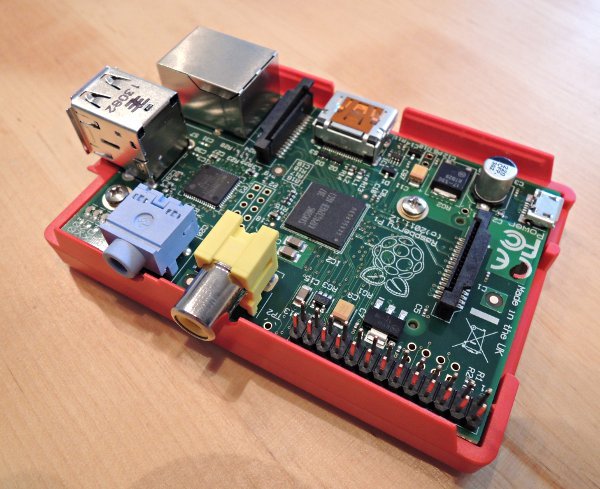
Let's get an overview of the board and its (many) connectors. This is a Model B, revision 2, made in Wales. It's shown bolted to the bottom half of a red plastic case, which is sold separately.
You can hover your mouse over each of the major components to see what it's called or what it's for.

It comes just as a board, so you'll need some extra gadgets to get it to work properly. As a rough guideline, here are some of the many possibilities:
| Power | into the microusb power socket | via a mains charger | from the wall socket |
| via a USB cable | from a powered USB hub | ||
| SD card | in the SD card slot | ||
| Video out | from the HDMI socket | via a HDMI cable | into the HDMI socket of your tv / monitor |
| via a HDMI cable and a HDMI/DVI converter | into the DVI socket of your monitor | ||
| via a HDMI/DVI converter and a DVI cable | into the DVI socket of your monitor | ||
| from the yellow RCA socket | via an RCA cable | into the yellow auxiliary input (not the antenna!) of your tv | |
| via an RCA cable and an RCA/Scart adapter | into the Scart socket of your tv | ||
| Sound out | over HDMI if you're using that | ||
| from the headphone socket | via a 3.5mm headphone cable | to headphones or speakers or amplifier | |
| via a 3.5mm/Cinch adapter and Cinch cable | to hifi amplifier | ||
| Internet | from the ethernet socket | via an ethernet cable | into your router |
| from a USB socket | maybe via a cable or hub | into a USB wireless dongle | |
| Keyboard / Mouse | from USB socket(s) | via USB cable | to a wired USB keyboard and/or mouse |
| via USB-PS/2 adapter | to a wired PS/2 keyboard and/or mouse | ||
| via USB wireless dongle | to a wireless keyboard and/or mouse |
Because there are only 2 USB sockets available, you may have to use a (preferably powered) USB hub if want to connect multiple USB devices. A case is optional, and there are currently many different colours and styles for sale.